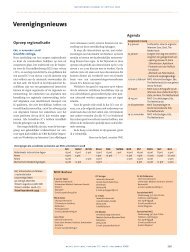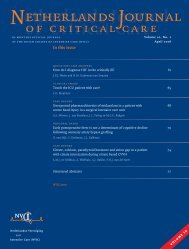Netherlands Journal
NJCC Volume 10, Oktober 2006
NJCC Volume 10, Oktober 2006
- No tags were found...
You also want an ePaper? Increase the reach of your titles
YUMPU automatically turns print PDFs into web optimized ePapers that Google loves.
netherlands journal of critical care<br />
Table 3: Assessment/scoring of the strengths listed in Table 2.<br />
0=unimportant, 10=of great importance.<br />
Strengths 1 2 3 4 5 6 7 8 Avg Sd Order<br />
Promising initial clinical data 6 7 9 9 10 8 9 9 8,4 1,3 1<br />
New concept/ mechanism of action 6 8 8 5 10 9 9 9 8,0 1,7 2<br />
Relatively low side-effects in heterogeneous patient-groups 9 8 9 7 10 5 7 8 7,9 1,6 3<br />
Consistent in vitro/in vivo data 8 5 8 7 10 6 9 9 7,8 1,7 4<br />
Works in fungi and yeast 8 5 8 7 10 5 7 9 7,4 1,8 5<br />
No resistance issue 8 8 8 4 10 2 8 9 7,1 2,7 6<br />
Promising in vitro data 7 5 8 5 10 5 9 8 7,1 2,0 7<br />
Makes sense 5 0 8 7 10 7 8 8 6,6 3,0 8<br />
Synergism with antifungal drugs 4 5 0 5 10 2 7 9 5,3 3,4 9<br />
Table 4: Scoring of the weaknesses listed in Table 2.<br />
Weaknesses 1 2 3 4 5 6 7 8 Avg Sd Order<br />
Probably expensive 8 10 10 10 9 9 9 9 9,3 0,7 1<br />
Unclear effect on long-term mortality in recent study by<br />
Pachl et al. [ref. 50]<br />
8 9 8 8 9 9 7 8 8,3 0,7<br />
2<br />
Unknown optimal dose 8 8 8 10 6 9 7 7 7,9 1,3 3<br />
Lack of clinical data 8 8 8 4 10 10 7 7 7,8 1,9 4<br />
No proven superiority over standard drugs 8 7 7 8 8 9 8 7 7,8 0,7<br />
5<br />
Unknown pharmacokinetic/PD profile 8 7 8 10 9 8 7 4 7,6 1,8 6<br />
Unknown optimal duration 8 8 8 10 6 9 7 5 7,6 1,6<br />
7<br />
Unknown additional effects of HSP90 8 6 4 10 8 10 7 7 7,5 2,0 8<br />
Few data on combinations with other anti-fungal drugs 8 7 8 6 8 7 8 6 7,3 0,9 9<br />
the treatment of invasive fungal infections, and (lipid formulations<br />
of )amphotericin-B represented the main therapeutic option. Indeed<br />
amphotericin-B remains the gold standard for antifungal treatment<br />
even at this time.<br />
The participants were then asked which functionaries in their hospital<br />
would be involved in the decision to introduce a new and potentially<br />
expensive drug such as Mycograb ® in their hospital. The<br />
functionaries mentioned by the participants are listed in table 1.<br />
Subsequently, the participants were asked to score the importance<br />
of these functionaries on a scale of 0-10, with 0 indicating (almost)<br />
no influence and 10 indicating great influence over the decision. The<br />
results are also listed in Table 1.<br />
Table 1. Role of different hospital functionaries in the decision to acquire<br />
and start using an expensive novel treatment such as Mycograb,<br />
and the influence of these functionaries as estimated by the participants<br />
expressed on a scale of 0-10. Columns 1-6 show the scores of<br />
the individual participants, the last two columns show the average<br />
scores with standard deviations.<br />
The ICU chairman/ICU management were thought to have the most<br />
influence on n this type of decision, closely followed by the hospital<br />
antibiotics committee (in which intensivists, microbiologists, infectious<br />
disease specialists and pharmacists are most frequently represented).<br />
One of the participants remarked that actually none of the parties<br />
had decisive influence, but that many had the power of veto, i.e.<br />
would be able to block the use of a new drugs. The introduction of<br />
this type of new drug into a hospital would thus require a certain<br />
degree of consensus among various functionaries. In many hospitals<br />
there is a form of structured discussion between intensivists, microbiologists<br />
and infectiologists regarding the use of novel antibiotics<br />
and antifungal therapy. Other participants disagreed; they indicated<br />
that in their hospital they had a certain budget for drugs in the ICU,<br />
which they could spend more or less as they wished. Certainly if the<br />
numbers as reported in the study by Pachl et al. hold up, the use of<br />
Mycograb ® would be efficacious and cost-effective, and thus would<br />
be likely to find its way to the patient without too much difficulty.<br />
Most of the participants agreed but reserved judgement because the<br />
results were still preliminary (the study had not yet been published<br />
at the time of the round table meeting), and no confirmatory studies<br />
were yet available.<br />
After the introduction and initial discussion the participants in<br />
the round table meeting were asked to perform a so-called SWOT<br />
(strengths, weaknesses, opportunities and threats) analysis for the<br />
use of Mycograb. In this regard strengths of Mycograb ® would be<br />
properties inherent to the drug that would increase the likelihood of<br />
its use; conversely, potential weaknesses are properties inherent to<br />
the drug that would hamper its use. Opportunities and threats are<br />
external factors, not directly linked to the drug itself, which could<br />
nevertheless influence its use. For example, the target mechanism of<br />
Mycograb (blocking HSP90) is inherent to the drug, and could be regarded<br />
as a strength; the side effects associated with currently available<br />
treatments are not inherent to Mycograb, but could still help its<br />
usage and thus represent an opportunity.<br />
After the procedure had been explained the participants were asked<br />
to name strengths and weaknesses of Mycograb, followed by opportunities<br />
and threats. When these factors had been named the participants<br />
were asked to score the arguments for relevancy and importance,<br />
again (as explained above) on a scale of 0-10, with 0 indicating<br />
total disagreement and 10 indicating total agreement. The results are<br />
shown in Tables 2, 3 and 4.<br />
neth j crit care • volume 10 • no 5 • october 2006<br />
591







